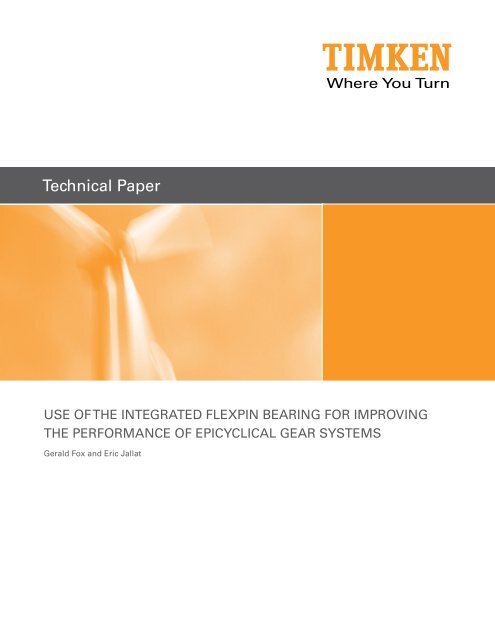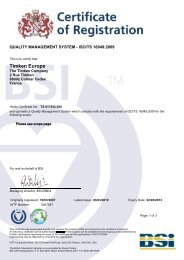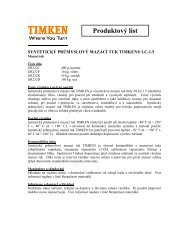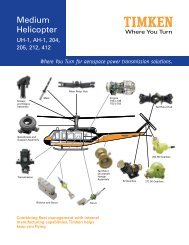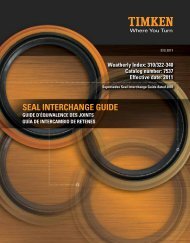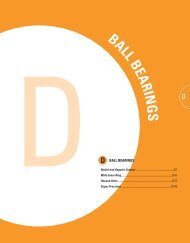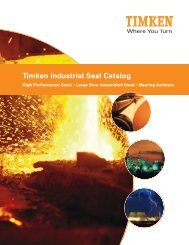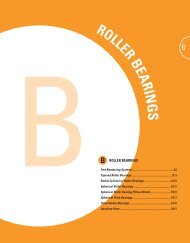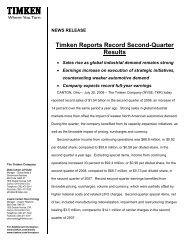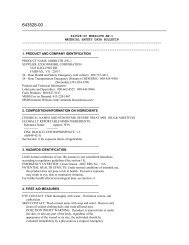Technical Paper - Timken
Technical Paper - Timken
Technical Paper - Timken
Create successful ePaper yourself
Turn your PDF publications into a flip-book with our unique Google optimized e-Paper software.
<strong>Technical</strong> <strong>Paper</strong><br />
USE OF THE INTEGRATED FLEXPIN BEARING FOR IMPROVING<br />
THE PERFORMANCE OF EPICYCLICAL GEAR SYSTEMS<br />
Gerald Fox and Eric Jallat
Abstract<br />
Epicyclical gear systems have typically been equipped with straddle-mounted planetary idlers having pins sup-<br />
ported on the input and output sides of the carrier. Torsional wind-up of the carrier, position accuracy of the pins, ma-<br />
chining tolerances of the planetary gear system components and bearings clearances can all contribute to a poor load<br />
sharing among the planetary idlers as well as misaligned gear contacts in the deflected state. Use of the double-canti-<br />
levered flexible pin concept to achieve better load sharing and gear contact patterns among a multiplicity of planetary<br />
idlers, has been used to improve reliability in advanced gear drives for many years. The consequence of this practice is<br />
to build a compliant epicyclical system that improves power density in the gear length direction because the probabili-<br />
ty of achieving a properly centered gear contact is increased. The Integrated Flexpin Bearing, the subject of this paper,<br />
is capable of achieving additional power density in the gear diameter direction through integration of bearing compo-<br />
nents, gearing and shafting. This paper presents one designer’s approach to optimizing an Integrated Flexpin Bearing<br />
to improve the reliability of an epicyclical gearbox.
Introduction - The Design Challenge<br />
Of An Epicyclical Gearing System<br />
An epicyclical gearing system is particularly well suit-<br />
ed for achieving a high-reduction ratio in a relatively small,<br />
power dense package. A typical straddle mounted plan-<br />
etary idler is shown in Fig. 1.<br />
FIGURE 1 – CONVENTIONAL PLANETARY IDLER<br />
This blend of features has made it a popular choice<br />
for the designers and, consequently, it has been incorpo-<br />
rated into countless types of equipment, including auto-<br />
mobile transmissions, off-highway equipment final drives,<br />
wind turbine gearboxes and cement mill crusher drives,<br />
to name a few.<br />
As with any type of power transmission system, the<br />
engineer is faced with many analytical challenges during<br />
the design phase to ensure that a highly reliable power<br />
train is achieved. In the case of an epicyclical gearing sys-<br />
tem, this challenge is made particularly difficult due to the<br />
complex interaction of revolving and rotating components<br />
as they transmit power.<br />
In the traditional epicyclical gearing system, where<br />
the distance between planetary gear centerlines is spec-<br />
ified by the design to be within a fixed range, it is wide-<br />
ly recognized that the load sharing is not equal among<br />
the planetary gear meshes. Similarly, the stress distribu-<br />
tion at each mesh point contains variability. Load shar-<br />
ing and stress distribution at each mesh point are heavi-<br />
ly influenced by the global design configuration, backlash<br />
tolerance, component design tolerances, manufacturing<br />
accuracy, component deflection and thermal distortion.<br />
See Fig. 2 which shows in exaggerated form that contact<br />
is made at the mesh points of planet a-1 before any con-<br />
tact is made at the mesh points of the other planets. In a<br />
rigid system, this condition imposes unbalanced loading<br />
among the planetary idlers.<br />
FIGURE 2 – GEAR MESH CONTACT VARIABILITY<br />
The traditional approach to accounting for this vari-<br />
ability is to apply safety factors during the design phase.<br />
Factors accounting for load distribution among plan-<br />
ets, the torsional wind up of the planetary carrier assem-<br />
bly, the contact pressure exerted on the gear faces and<br />
many more are published by AGMA and other sources<br />
and are used frequently in today’s design process with<br />
good success. Additionally, very advanced computer<br />
programs linking finite element analysis with gear design<br />
algorithms and with the safety factors just mentioned are<br />
commercially available and are used by most gear de-<br />
sign centers in conjunction with their own proprietary de-<br />
sign practices.
But, for just about all equipment types, economics<br />
dictate the need for increased power density and im-<br />
proved reliability. A common approach is to attempt to<br />
build in more planets, thereby reducing forces and stress-<br />
es at each mesh point. But, as planets are added, so is<br />
uncertainty about just how much power each planet is<br />
transmitting. Therefore, the safety factors (for example,<br />
K gamma) are applied to maintain conservatism of de-<br />
sign that defeats some of the effort to achieve more pow-<br />
er density.<br />
Alternatively, designers have applied a number of nov-<br />
el designs with various levels of success to build epicy-<br />
clical gearing systems that help distribute loading among<br />
planets more evenly, thereby increasing power density. In<br />
general, such improvements employ components in the<br />
gear train that are elastically compliant and are intended<br />
to compensate for clearance variations without imparting<br />
any negative operating characteristics. Some include:<br />
(1) Flexible ring gears have been applied, but the effective-<br />
ness of this approach is not universal because the radi-<br />
al deflections of the ring gear are not enough to compen-<br />
sate for the clearance (backlash) variations present at the<br />
various mesh points<br />
(2) Floating ring gear system (used in some off-highway<br />
applications)<br />
(3) Floating sun gear<br />
(4) Floating planet carrier<br />
(5) Double helical gear with floating members<br />
(6) Floating planetary gear, also called flexible pin or ab-<br />
breviated to flexpin. [1]<br />
The remainder of this paper will focus around ad-<br />
vancement of number 6 in the form of a new product<br />
called the Integrated Flexpin Bearing (to be referred to<br />
from this point on as the IFB).<br />
What is the Integrated Flexpin<br />
Bearing?<br />
The flexible pin design mentioned on line 8 above was<br />
created in the mid-1960s by British inventor Ray Hicks. It<br />
is based on achieving an equal load distribution among<br />
planets by anchoring them onto a planetary carrier in a<br />
torsionally compliant fashion. Instead of fixing the an-<br />
gular positions of the planet gears, the flexible pins were<br />
designed so that they could deflect independently in a<br />
circumferential direction, which ultimately helps equalize<br />
the force distribution among the planets while transmit-<br />
ting torque at various levels. This feature will be referred<br />
to henceforth in this paper as torsional compliancy.<br />
Torsional compliancy was achieved by applying a<br />
double- cantilever beam design that is illustrated in Fig. 3.<br />
Simply stated, when the two tangential forces are applied<br />
to the flexpin gear, the angular deflection caused by the<br />
bending of the pin cantilevered from a carrier wall can be<br />
offset in the opposite direction by the angular deflection<br />
caused by bending of the sleeve cantilevered from the<br />
other end of the pin. If sections of the pin and sleeve are<br />
carefully designed with that goal in mind, the deflection<br />
at each gear contact will follow a circumferential transla-<br />
tion meaning the axis of the gear contact will not tip side<br />
to side from angular positioning inaccuracy nor lead from<br />
torsional wind up of the carrier.<br />
FIGURE 3 – DEFLECTION CHARACTERISTIC OF THE FLEXIBLE PIN
Flexible pins have been designed into various types<br />
of equipment and the designs have typically included as-<br />
sembly of separable components including gears, pins,<br />
mounting sleeves, backing plates, capscrews and various<br />
type of rolling element bearing races and bushings. See<br />
Fig. 4 for a typical mounting arrangement.<br />
FIGURE 4 – TYPICAL FLEXIBLE PIN DESIGN<br />
Such a design achieves the objective of creating a<br />
torsionally compliant system as illustrated in Fig. 5. Ad-<br />
ditionally, since gears are less prone to be tipped off axis<br />
because the single sided planetary carrier can no longer<br />
wind up, it can be argued that gear contacts have a much<br />
higher probability of remaining centered at all meshes. It<br />
follows then that the flexible pin permits the designer to<br />
specify narrower gears and still avoid stress concentra-<br />
tions at the edges of the face. Power density is therefore<br />
improved in the axial direction.<br />
FIGURE 5 – COMPLIANT PLANET CARRIER SYSTEM USING FLEX-<br />
IBLE PINS<br />
A substantial improvement can be realized if one<br />
takes advantage of modern bearing technology and ad-<br />
vances the entire design to the next level, which is full in-<br />
tegration of the gear with the outer races of the bearings,<br />
and full integration of the sleeve with the inner races of<br />
the bearings. This advancement is the Integrated Flex-<br />
pin Bearing (IFB) and is illustrated in Fig. 6. This novel ap-<br />
proach to design and construction of the flexible pin ar-<br />
rangement provides increased opportunity to add power<br />
density to an epicyclical gear drive in the axial and radial<br />
directions. The beam strength of the sleeve and gear are<br />
both increased from the integration of the bearing com-<br />
ponents allowing for downsizing especially in the radial<br />
direction.<br />
FIGURE 6 – CROSS-SECTIONAL VIEW OF THE IFB<br />
Other features of the IFB include:<br />
(1) Elimination of sub-assembling the flexible pin arrange-<br />
ment<br />
(2) Elimination of many components for weight savings<br />
and cost reduction<br />
(3) There are no tight-fitted outer races that can still pre-<br />
cess inside the gear creating wear, debris and extra bear-<br />
ing clearance
(4) Unitized construction permits elimination of the bear-<br />
ing retainer and insertion of more rolling elements, adding<br />
to bearing capacity and bearing life<br />
(5) Very precise control of the mounted bearing clearance<br />
range at the bearing factory for maximizing bearing life,<br />
gear positioning and consistency of deflection between<br />
adjacent IFB’s. Note: A combination of press fitting and<br />
welding the stationary adjustment rib at its required po-<br />
sition on the inner race sleeve has been developed and<br />
thoroughly tested to ensure adequate holding force and<br />
durability at loads significantly in excess of the maximum<br />
applied loads.<br />
(6) Higher assurance of equally distributed loading to each<br />
bearing row<br />
Design of the Integrated Flexpin<br />
Bearing<br />
There are many factors influencing the global deflec-<br />
tion characteristics of the IFB including:<br />
(1) Applied loading<br />
(2) Gear profile and section<br />
(3) Number, size and location of rolling elements<br />
(4) Internal bearing clearance<br />
(5) Sleeve section<br />
(6) Length and diameter of the of each cantilever<br />
(7) Pin length and diameter<br />
(8) Pin groove geometry<br />
(9) Planetary carrier deflection<br />
To specify an IFB design, the authors’ company has<br />
developed an advanced design model that combines a<br />
parametric 2D and 3D finite element analysis coupled with<br />
a Fourier series representation of the varying conditions<br />
of load distribution on the raceways. This allows compu-<br />
tational time to be significantly compressed. Using this<br />
proprietary modeling technique (also accounts for deflec-<br />
tion of the carrier), the radial deflection of the IFB and gear<br />
misalignment can now be thoroughly assessed and accu-<br />
rately predicted.<br />
A typical IFB design is illustrated in Fig. 7. U.S. and<br />
International patents have been applied for.<br />
FIGURE 7 – INTEGRATED FLEXPIN BEARING ASSEMBLY<br />
Minimum pin section (A) and gear section (B) dictate<br />
to a large degree the overall size of the IFB. See previ-<br />
ous Fig. 6.<br />
Other critical inputs include:<br />
(1) Load spectrum<br />
(2) Speed spectrum<br />
(3) Minimum required bearing life<br />
(4) Gear dimensions or tooth volume available and gear<br />
ratio<br />
(5) Lubrication condition (temperature, viscosity, surface<br />
finishes)<br />
(6) IFB component material<br />
(7) Mechanical characteristics of the planetary carrier<br />
(8) Minimum radial displacement required under the nom-<br />
inal load<br />
(9) Maximum permissible gear misalignment
FEA modeling yields outputs such as those illustrat-<br />
ed in Fig. 8 and Fig. 9. These allow for close study of load<br />
distribution, stress concentration, and the global IFB de-<br />
flection characteristics that ultimately influence the gear<br />
and bearing lives.<br />
FIGURE 8 – DEFLECTION ANALYSIS OF THE IFB PIN<br />
FIGURE 9 – STRESS ANALYSIS OF THE IFB SLEEVE<br />
Parametric FEA modeling facilitates iteration so that<br />
design optimization of the IFB may be achieved in a rea-<br />
sonably short period of time. Assuming all input is avail-<br />
able, the modeling and analysis may be achieved in ap-<br />
proximately one day’s work. Numerous dimensional<br />
variables are investigated to ascertain influence on the<br />
IFB deflection characteristics. They are all interrelated<br />
and will impact deflection to varying degrees among dif-<br />
ferent gearbox designs. Two charts are offered in Fig-<br />
ures 10 and 11 showing the influences of groove diam-<br />
eter, pin diameter, groove length and pin length on gear<br />
misalignment.<br />
FIGURE 10 – DIAMETER VS. GEAR MISALIGNMENT<br />
FIGURE 11 – LENGTH VS. GEAR MISALIGNMENT<br />
Similar graphs could be shown for many other vari-<br />
ables such as groove location, gear section, sleeve di-<br />
ameter, bearing internal geometry, and bearing setting.<br />
All these and more are explored during the optimization<br />
process.<br />
Properly designed, the desired radial displacement<br />
of the IFB results in circumferential translation of the gear<br />
contact centerline with nil misalignment. It should re-<br />
main somewhat proportional to the torque applied to the<br />
system. Analytical results are graphed in Fig. 12. Static<br />
testing conducted subsequently indicates a modest de-<br />
parture from perfect linearity, especially at lighter torque,<br />
because of the complexity in modeling the tight fitted con-<br />
nection between the flexible pin and the carrier wall. Nev-
ertheless, the error is small enough to be within normally<br />
required design accuracy.<br />
FIGURE 12 – PERCENT LOADING VS. RADIAL DISPLACEMENT OF<br />
THE IFB<br />
Epicyclical Gearing System Design<br />
Perhaps if there is a negative aspect of adapting an<br />
IFB design, it is that pins are cantilevered from a single-<br />
sided carrier. It follows that compared with pins support-<br />
ed at both ends in a typical planetary carrier design, the<br />
available shear area per flexible pin is divided by 2. Ad-<br />
ditionally, the bending moment increases because of the<br />
cantilevered design. It follows, therefore, that when us-<br />
ing the IFB, more planets must often be added in order to<br />
maintain acceptable stress and deflection levels.<br />
Adding more planets has positive and negative ef-<br />
fects. On the positive side, adding planets should reduce<br />
the load per planet. On the negative side, adding plan-<br />
ets on the same carrier pitch diameter could necessitate<br />
reducing the planet gear diameter so that they do not in-<br />
terfere with one another, therefore reducing the maximum<br />
gear ratio possible when using lesser pins and larger di-<br />
ameter planet gears. This is a valid observation, but it can<br />
be compensated for in many instances by shifting part of<br />
the required ratio to other stages of the gear train.<br />
Another argument on the negative side that may be<br />
refuted is that adding flexpins will worsen load distribu-<br />
tion on a percentage basis (K gamma increases or wors-<br />
ens). This is often the case using the rigid, fixed distance<br />
straddle carrier design; however, the torsional compliancy<br />
afforded by the IFB design in large part compensates for<br />
this. Test results in Fig. 13 show how the load-sharing fac-<br />
tor K gamma is reduced using flexible pins [2][3]. For ex-<br />
ample, using 7 pins, K gamma published by AGMA equals<br />
1.47 while K gamma using the flexpin equals 1.20.<br />
FIGURE 13 – LOAD SHARING FACTOR COMPARISON<br />
Another objection commonly raised is that by using<br />
more planets, weight is increased. This does not have to<br />
be the case. If the system using the IFB is designed and<br />
manufactured properly, narrower gears may be employed<br />
because gear misalignment will be minimized, keeping<br />
the Hertzian contact well centered on the gear face and<br />
away from the edges. In standard terms, KH beta is im-<br />
proved and easier to predict.<br />
Epicyclical gearing systems can be designed in a<br />
number of single- and double-stage configurations, de-<br />
pending on space available and the ratio desired. One<br />
arrangement that has been applied to wind turbine gear-<br />
boxes is shown in Fig. 14. Its ratio (N2/N1) happened to<br />
be 12.2/1 [4].<br />
FIGURE 14 – TYPICAL EPICYCLICAL GEARING SYSTEM INCOR-<br />
PORATING THE IFB
Preloaded Tapered Roller Bearing –<br />
Preferred Choice for the IFB<br />
The preloaded tapered roller bearing imparts supe-<br />
rior performance characteristics to an IFB design, and is<br />
commonly regarded as the preferred bearing choice. It<br />
can be shown analytically that a preloaded tapered roll-<br />
er bearing will offer advantages over other bearing types<br />
possessing larger amounts of radial clearance, especially<br />
when the IFB is required to operate with misaligned gear<br />
contacts.<br />
In performing the usual bearing calculation, a com-<br />
mon assumption is that the gear contact remains cen-<br />
tered. In fact, some percentage of units from a population<br />
of a specific epicyclical gearing design will operate with<br />
off-centered gear contacts. Off-centered gear contacts<br />
can be created by a number of variables including:<br />
(1) Inadequate lead compensation for varying amounts of<br />
torsional wind up of a 2-sided carrier<br />
(2) An improperly designed flexpin deflection character-<br />
istic<br />
(3) Misaligned carrier pin holes<br />
(4) Component wear<br />
(5) Excess bearing clearance<br />
(6) Improperly designed or machined gear profiles<br />
When gear contacts are off-center, the pressure cen-<br />
troid of the gear contact is shifted side to side, creating<br />
an uneven load distribution on the bearings. Compound-<br />
ing this is that when one or both gear contacts shift, the<br />
separating forces are no longer directly opposed, and an<br />
overturning moment is created. This new distribution of<br />
loading now affects not only the bearing life calculation<br />
but also the angle of gear misalignment.<br />
Figure 15 has been generated using proprietary soft-<br />
ware developed by the authors’ company. It illustrates,<br />
for one set of gearing, how stress along the gear face is<br />
shifted at varying degrees of misalignment. It also shows<br />
how the centroid shifts off-center as well.<br />
FIGURE 15 – REDISTRIBUTION OF STRESS AND CONTACT CEN-<br />
TROID VS. GEAR ALIGNMENT ANGLE<br />
Figures 16A and 16B show an analytical comparison<br />
of radial displacements of a planetary idler equipped with<br />
preloaded taper roller bearings and cylindrical roller bear-<br />
ings having various amounts of radial clearance. Bear-<br />
ings evaluated were approximately 150 mm bearing pitch<br />
diameter at the roller centerlines and loaded to approxi-<br />
mately 190% of the rated capacity at 90 million revolu-<br />
tions. In figure 16A, the gear contact is centered for both<br />
meshes on the planetary idler. From figure 16B, it is ap-<br />
parent that various amounts of mounted clearance in the<br />
cylindrical roller bearing, whether intended by specifica-<br />
tion or unintended by manufacturing error (as illustrated<br />
by the lower plot), add directly to the radial displacements,<br />
and are greater than those of the preloaded tapered roller<br />
bearing. It follows that variability of clearance from plan-<br />
et to planet within a carrier merely adds to the variation of<br />
load distribution among the planets.
FIGURE 16A – PLANET WITH CENTERED GEAR CONTACT<br />
FIGURE 16B – RADIAL DISPLACEMENT WITH CENTERED GEAR<br />
CONTACTS<br />
As stated above, gear contacts are oftentimes not<br />
perfectly centered, as shown in Fig. 17A. Figure 17B is<br />
a plot showing comparison again of the various bearing<br />
arrangements when the centroid of the gear contact is<br />
shifted 60% to one side or the other. Under this condi-<br />
tion, both bearings translate radially and because load-<br />
ing is shifted more onto one of the bearing rows, a mis-<br />
alignment angle is introduced in the “Y” direction. The<br />
preloaded tapered roller bearing arrangement begins<br />
without clearance so that the resulting displacements<br />
are minimized, thereby reducing the misalignment an-<br />
gle. The lightly preloaded tapered roller bearing arrange-<br />
ment shows slight improvement compared with a cylin-<br />
drical roller bearing having normal mounted clearance,<br />
and substantial improvement compared with one set with<br />
higher clearance.<br />
FIGURE 17A – PLANET WITH OFFSET GEAR CONTACT<br />
FIGURE 17B – RADIAL DISPLACEMENT WITH OFFSET GEAR CON-<br />
TACTS ON ONE SIDE<br />
The two gear contacts of a planetary idler may also<br />
be offset on opposite sides. In other words, the gear con-<br />
tact between planet and ring gear may be offset left of the<br />
theoretical centerline to varying degrees, while the gear<br />
contact between planet and sun gear may be offset to the<br />
right by varying degrees. When this condition occurs, the<br />
separating forces will no longer oppose and will induce<br />
an overturning moment. Figure 18A depicts this scenar-<br />
io when the mesh centroid between the planet and ring<br />
gear is 60% of half the face width in one direction, while<br />
the mesh centroid between the planet and sun gear is the<br />
same distance in the opposite direction. Because the tan-<br />
gential forces in our example are offset equally and remain<br />
in the same direction, radial deflection in the “y” direction<br />
remains unaffected. However, the moment loading creat-<br />
ed by the offset separating forces creates radial displace-
ment, tilting and gear face misalignment in the “ZZ” plane<br />
of the paper. In Fig. 18B it is shown that the lightly pre-<br />
loaded tapered roller bearing reduces these movements<br />
and misalignments.<br />
FIGURE 18A – PLANET WITH OVERTURNING MOMENT<br />
FIGURE 18B – RADIAL DISPLACEMENT WITH OVERTURNING MO-<br />
MENT<br />
Unlike the flexible pins shown in figure 4, the IFB is a<br />
unitized bearing package that has the unique feature of<br />
having its internal clearance pre-set at the bearing facto-<br />
ry to very exacting specifications. This ensures that the<br />
mounted clearance variation among IFB assemblies will<br />
be miniscule, which means that the IFB deflection charac-<br />
teristics will be extremely consistent within a large popu-<br />
lation of product. Planet-to-planet backlash variation will<br />
be minimized. Obviously, this will have an equal impact<br />
on backlash variation within a population of gear drives,<br />
as well.<br />
<strong>Timken</strong> Static Testing<br />
Static testing was designed and conducted at the au-<br />
thors’ company to confirm the accuracy of the analytical<br />
models. Figure 19 shows the test bed on which all exper-<br />
iments were conducted. An IFB was cantilevered from<br />
a massive and rigidly supported carrier wall, keeping in<br />
mind that it was necessary to be able to discern between<br />
the deflection of the IFB and deflection of the carrier wall<br />
as data was collected and evaluated. This was accom-<br />
plished quite successfully so that values derived for com-<br />
parison are accurate.<br />
FIGURE 19 – STATIC DEFLECTION TEST STAND<br />
Displacements were measured at numerous critical<br />
locations on the IFB and carrier wall with LVDT probes, as<br />
well as dial indictors. Strain gauges were installed on the<br />
pin fillet radius and between the planet carrier and pin to<br />
confirm our FEA predictions.<br />
Figure 20 shows comparisons between measured<br />
and calculated results. The percentage of error is with-<br />
in reasonable accuracy for design purposes verifying that<br />
the design tool may now be used with confidence.<br />
Gear misalignment +22 %<br />
Radial deflection +5 %<br />
Stress level +10 %<br />
Linear behaviour +15 %<br />
FIGURE 20 – STATIC TEST RESULTS<br />
Measured / calculated<br />
KHb +6% (see note below)
Note: Improvement value considers planet gear and<br />
planet carrier deflection only. Ring and sun gear profiles<br />
are assumed to have 0 error. KHb values to be confirmed<br />
with additional dynamic testing.<br />
Dynamic Testing<br />
Dynamic testing was performed in conjunction with<br />
Maag AG on a newly developed gearbox for wind turbines.<br />
This gearbox was designed in response to the Wind Tur-<br />
bine Industry’s expressed need for a gearbox that pos-<br />
sesses sufficient compliancy to withstand a highly fluc-<br />
tuating duty cycle, common in turbulent wind conditions.<br />
Among other objectives during the dynamic testing,<br />
assessing the gear contact patterns became of vital im-<br />
portance, especially since the Maag gearbox contains<br />
seven IFBs on the high-torque input carrier and five more<br />
on the lower-torque carrier.<br />
FIGURE 21 shows the test setup. Two gearboxes<br />
were connected in-line between their low-speed, high-<br />
torque shafts. Torque was applied at varying levels into<br />
the gearboxes with opposing hydraulic cylinders connect-<br />
ed to the gearbox mounting pins. Rotation was provid-<br />
ed by an electric motor connected to one of the sun gear<br />
output shafts. The power necessary for the electric mo-<br />
tor to drive the test apparatus was equivalent to the total<br />
power losses.<br />
FIGURE 21 – DYNAMIC TEST STAND<br />
Various parameters were measured. Figure 22 shows<br />
test results for load sharing among planets (K gamma fac-<br />
tor). Two important observations are immediately appar-<br />
ent. First, while the usual published values of K gamma<br />
are constant, K gamma using the IFB decreases as load<br />
increases. Stated another way, load distribution among<br />
planets improves as load increases when using the IFB.<br />
Secondly, and most importantly, K gamma is sub-<br />
stantially less than normally published values. In the case<br />
shown here, at 100% loading, K gamma is reduced 27%.<br />
Stated another way, the design load for each planet can<br />
be reduced by the same amount, creating an opportunity<br />
for downsizing or improving reliability.<br />
FIGURE 22 – LOAD SHARING AMONG PLANETS<br />
IFB Design Guidelines for Wind Turbine<br />
Gearboxes<br />
(1) Spur gears are much preferred over helical gear-<br />
ing. Even with shallow helix angles, the overturning mo-<br />
ments produced by helical gearing thrust forces will not<br />
permit an IFB to be designed with optimal compliance.<br />
(2) Various epicyclical gearing system configurations<br />
are possible.<br />
(3) Gear faces and rolling elements can be coated with<br />
special surface treatments to improve life and efficiency.
(4) Max desirable IFB raceway contact stress for the<br />
weighted operating torque condition should be less than<br />
1450 Mpa.<br />
(5) Required bearing life should be 175,000 hours L-<br />
10 using advanced bearing analysis tools.<br />
(6) Gear wall section height at the center of the gear<br />
(between the two bearing rows) shall be 3 times the gear<br />
module.<br />
(7) The radial deflection (circumferential translation)<br />
under the nominal loading condition should be at least<br />
equal or greater than the nominal gear backlash.<br />
(8) For wind turbine gearbox applications, the IFB<br />
must maintain design integrity at loading 3 times the max-<br />
imum operating load and 2 times the extreme load con-<br />
dition.<br />
Conclusion<br />
Use of the Integrated Flexpin Bearing is a natural pro-<br />
gression in the field of epicyclical gearing system design.<br />
It affords the designer an effective approach to improving<br />
load distribution and reliability.<br />
Perhaps equally important, new analytical methods<br />
and tools have now been developed to ensure that the<br />
complex workings of the IFB can be determined with suf-<br />
ficient accuracy and within a reasonable amount of time<br />
for use in the design phase. Results of prototype testing<br />
should therefore be more predictable, reducing overall de-<br />
sign cycle time.<br />
These tools have been validated with testing report-<br />
ed by the authors’ company and Maag AG. As more de-<br />
signs are created, more knowledge will be accumulated<br />
and tools will continue to be refined.<br />
Acknowledgments<br />
Urs V. Giger, Gear Consultant, Zurich, Switzerland<br />
Maag AG associates for their extensive and enthusi-<br />
astic cooperation throughout this development project.<br />
Raymond J. Hicks (Gearing Consultant and retired<br />
owner of Compact Orbital Gears) for inventing the flexible<br />
pin design and for his expert guidance.<br />
The <strong>Timken</strong> Company’s associates whose collabor-<br />
ative efforts have made the development of the IFB pos-<br />
sible.<br />
References<br />
[1] HENRIOT G., 1979, « Traité théorique des<br />
engrenages TOME I », Bordas, Paris, pp 620 – 631.<br />
JALLAT.<br />
[2] MAAG Gear AG, Facsimile Exchange with E.<br />
[3] ANSI/AGMA standard 6123-A88, 1988, “Design<br />
Manual for Enclosed Epicyclic Metric Module Gear Drive,<br />
p25.<br />
[4] MAAG Gear AG, 1990, “ MAAG Gear book “,<br />
Scellenberg Druck AG, Zurich, p 235.
Bearings • Steel •<br />
Precision Components • Lubrication •<br />
Seals • Remanufacture and Repair •<br />
Industrial Services<br />
www.timken.com<br />
<strong>Timken</strong> ® is the registered trademark of<br />
The <strong>Timken</strong> Company.<br />
© 2008 The <strong>Timken</strong> Company<br />
Printed in U.S.A.<br />
03-05 Order No. 5867


